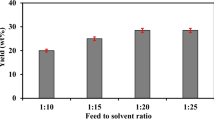Abstract
Cuphea seed oil (CSO) is a source of decanoic acid which is useful in the preparation of estolide lubricants among other applications. Decanoic acid and other free fatty acids (FFA) can be hydrolyzed from CSO using a catalyst like KOH, followed by neutralization with HCl and extraction with hexane. This procedure, however, uses caustic materials, hazardous solvents and generates waste salt streams. This study investigated the use of water without catalysts to hydrolyze CSO in a continuous flow tubular reactor. Parameters such as the interaction of pressure and temperature, temperature, water to cuphea oil fatty acid residue (H2O:COFAR) molar ratio, and flow rate were examined. The lowest conversions of CSO to FFA were at the lowest temperature (i.e., 300 °C) and the hydrolysis was ca. 90% at 350 °C and 13.8 MPa and ca. 80% at 365 °C and 13.8 MPa. Hydrolysis increased with pressure and leveled off at 13.8 MPa. Hydrolysis increased with temperature and leveled off at ca. 330 °C. The optimal H2O:COFAR molar ratio was found to be 6:1. Conversion rates were inversely proportional to flow rate with 95% conversion at the lowest flow rate (i.e., 0.25 mL/min) corresponding to the longest residence time (i.e., ca. 45.2 min). These results demonstrate a continuous subcritical water process for hydrolyzing CSO to FFA that is effective, requires no catalysts and does not generate a waste salt stream.





Similar content being viewed by others
References
Graham SA, Hirsinger F, Robbelen G (1981) Fatty acids of cuphea (Lythraceae) seed lipids and their systematic significance. Am J Bot 68:908–917
Thompson AE (1984) Cuphea: a potential new crop. Hortscience 19:352–354
Hirsinger F (1985) Agronomic potential and seed composition of cuphea, an annual crop for lauric and capric seed oils. J Am Oil Chem Soc 62:76–80
Knapp SJ, Tagliani LA, Roath WW (1991) Fatty acid and oil diversity of Cuphea viscosissima: a source of medium-chain fatty acids. J Am Oil Chem Soc 68:515–517
Gesch RW, Cermak SC, Isbell TA, Forcella F (2005) Seed yield and oil content of cuphea as affected by harvest date. Agron J 97:817–822
Cermak SC, Isbell TA (2004) Synthesis and physical properties of cuphea-oleic estolides and esters. J Am Oil Chem Soc 81:297–303
Phippen WB, Isbell TA, Phippen ME (2006) Total seed oil and fatty acid methyl ester contents of cuphea accessions. Ind Crops Prod 24:52–59
Yoshida S, Iinuma M (2004). Wood preservative. US Patent 6827949 B2
Goettsche R., Borck, H-A. (1994). Wood preservative compositions having activity against termites and fungi. US Patent 5276029
Velamakanni BV, Mitra SB,Wang D, Scholz MT, Aasen SM (2006). Hardenable antimicrobial dental compositions and methods. US Patent 20060205838
Hohener A, Frick R (2003). Fabric softener composition. US Patent 6583105 B1
Hoppe U, Engel W (1989). Cosmetic agents or hair. US Patent 4839165
Ishii H, Mikami N, (1995). Preparation of n-(long-chain acyl) amino acid esters as moisture-holding agents and emulsifiers for cosmetics and skin medicaments. Japan Patent 93-263900
Cermak SC, Isbell TA (2000). Biodegradable oleic estolide ester having saturated fatty acid end group useful as lubricant base stock, US Patent 6316649
Cermak SC, Isbell TA (2001) Synthesis of estolides from oleic and saturated fatty acids. J Am Oil Chem Soc 78:557–565
Cermak SC, Isbell TA (2003) Synthesis and physical properties of estolide-rased functional fluids. Ind Crops Prod 18:183–196
Cermak SC, Isbell TA (2002) Physical properties of saturated estolides and their 2-ethylhexyl esters. Ind Crops Prod 16:119–127
Holliday RL, King JW, List GR (1997) Hydrolysis of vegetable oils in sub and supercritical water. Ind Eng Chem Res 6:932–935
King JW, Holliday RL, List GR (1999) Hydrolysis of soybean oil in a subcritical water flow reactor. Green Chem 1:261–264
Cermak SC, John AL, Evangelista R (2007) Enrichment of decanoic acid in cuphea fatty acids by molecular distillation. Ind Crops Prod 26:93–99
Yoshida H, Terashima M, Takahashi Y (1999) Production of organic acids and amino acids from fish meat by sub-critical water hydrolysis. Biotechnol Prog 15:1090–1094
Krammer P, Vogel H (2000) Hydrolysis of esters in subcritical and supercritical water. J Supercrit Fluids 16:189–206
Tavakoli O, Yoshida H (2006) Squid oil and fat production from squid wastes using subcritical water hydrolysis: free fatty acids and transesterification. Ind Eng Chem Res 45:5675–5680
Minami E, Saka S (2006) Kinetics of hydrolysis and methyl esterification for biodiesel production in two-step supercritical methanol process. Fuel 85:2479–2483
Firestone D (ed) (1994) Official and tentative methods of the American Oil Chemists’ Society, 4th edn. AOCS, Champaign
Isbell TA, Cermak SC (2004) Purification of meadowfoam monoestolide from polyestolide. Ind Crops Prod 19:113–118
Eller FJ, Cermak SC, Taylor SL (2011) Supercritical carbon dioxide extraction of cuphea seed oil. Ind Crops Prod 33:554–557
Acknowledgments
The authors wish to thank Scott Taylor and Geoffrey Girsch for their technical assistance.
Author information
Authors and Affiliations
Corresponding author
Additional information
Names are necessary to report factually on available data; however, the USDA neither guarantees nor warrants the standard of the product, and the use of the name USDA implies no approval of the product to the exclusion of others that may also be suitable.
About this article
Cite this article
Eller, F.J., Teel, J.A. & Palmquist, D.E. Continuous Hydrolysis of Cuphea Seed Oil in Subcritical Water. J Am Oil Chem Soc 88, 1455–1461 (2011). https://doi.org/10.1007/s11746-011-1798-8
Received:
Revised:
Accepted:
Published:
Issue Date:
DOI: https://doi.org/10.1007/s11746-011-1798-8




